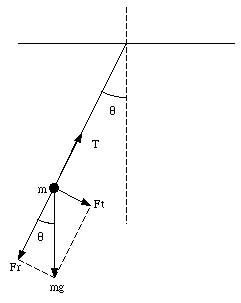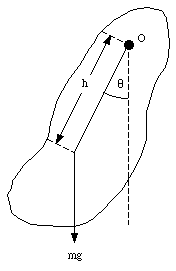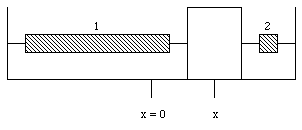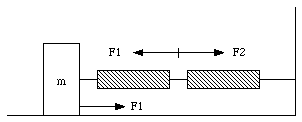
Any motion that repeats itself at regular intervals is called harmonic motion. A particle experiences a simple harmonics motion if its displacement from the origin as function of time is given by

where xm, [omega] and [phi] are constants, independent of time. The quantity xm is called the amplitude of the motion and is the maximum displacement of the mass. The time-varying quantity ([omega]t + [phi]) is called the phase of the motion and [phi] is called the phase constant. The phase constant is determined by the initial conditions. The angular frequency [omega] is a characteristic of the system, and does not depend on the initial conditions. The unit of angular frequency is rad/s. The period T of the motion is defined as the time required to complete one oscillation. Therefore, the displacement x(t) must return to its initial value after one period
x(t) = x(t + T)
This is equivalent to

Using the relation

it is immediately clear that

The number of oscillations carried out per second is called the frequency of the oscillation. The symbol for frequency is [nu] and its unit is the Hertz (Hz):
1 Hz = 1 oscillation per second = 1 s-1
The period T and the frequency [nu] are related as follows

The velocity of an object carrying out simple harmonic motion can be calculated easily

The positive quantity [omega] xm is called the velocity amplitude and is the maximum velocity of the object. Note that the phase of the velocity and displacement differ by 90deg.. This means that the velocity is greatest when the displacement is zero and vice versa. The acceleration of an object carrying out simple harmonic motion is given by

The positive quantity [omega]2 xm is the acceleration amplitude am. Using the expression for x(t), the expression for a(t) can be rewritten as

This shows that the acceleration is proportional to the displacement, but opposite in sign. The force acting on the mass can be calculated using Newton's second law

This equation of force is similar to the force exerted by a spring (Hooke's law)
F = - k x
Comparing these last two equations we conclude that
k = m [omega]2
and
" Simple harmonic motion is the motion executed by a particle of mass m, subject to a force F that is proportional to the displacement of the particle, but opposite in sign. "
The system shown in Figure 15.1 forms a simple harmonic oscillator. It will oscillate with an angular frequency [omega] given by

The period T of the oscillation is given by

The total mechanical energy of the simple harmonic oscillator consist of potential and kinetic energy. The potential energy of the system is given by


Figure 15.1. A simple harmonic oscillator.
The kinetic energy of the system is given by

The total mechanical energy of the system can now be calculated

The total mechanical energy of the simple harmonic oscillator is constant (independent of time). However, the kinetic and potential energies are functions of time.
Example: The torsion pendulum
The operation of a torsion pendulum is associated with twisting a suspension wire. The motion described by the torsion pendulum is called angular simple harmonic motion. The restoring torque is given by

where [kappa] is a constant that depends on the properties of the suspension wire (its length, diameter and material). For a given torque we can calculate the angular acceleration a

or

Comparing this equation with the relation between the linear acceleration and the linear displacement of an object, we conclude that

The period of the torsion pendulum is given by

Example: Classical simple pendulum
The classical simple pendulum is shown in Figure 15.2. It consists out of a mass m suspended from a massless string of length L. The forces acting on the mass are the gravitational force m g and the tension T in the string. The radial component of the gravitational force, m g cos([theta]), determines the tension in the wire, but will not alter the motion of the mass. The tangential component of the gravitational force, m g sin([theta]), is always directed towards the rest position of the pendulum. This component of the gravitational force is called the restoring force:

For small angles, sin([theta]) ~ [theta]. This shows that

where s is the displacement of the mass along the arc. Again we conclude that the restoring force is proportional to the displacement, and of opposite sign. The motion is therefore that of a harmonic oscillator. The acceleration of the mass is related to the displacement s

Figure 15.2. Classical simple pendulum.

This immediately indicates that the angular frequency [omega] is given by

and therefore, the period of the motion is given by


Figure 15.3. The physical pendulum.
Example: The Physical Pendulum
In the real world pendulums are far from simple. In general, the mass of the pendulum is not concentrated in one point, but will be distributed. Figure 15.3 shows a physical pendulum. The physical pendulum is suspended through point O. The effect of the force of gravity can be replaced by the effect of a single force, whose magnitude is m g, acting on the center of gravity of the pendulum (which is equal to the center of mass if the gravitational acceleration is constant). The resulting torque (with respect to O) is given by

where h is the distance between the rotation axis and the center of gravity. In the limit of small angles, this torque can be rewritten as

The angular acceleration a of the pendulum is related to the torque [tau] and the rotational inertia I

We therefore conclude that

This is again the equation for harmonic motion with an angular frequency given by

and a period equal to

Note that the simple pendulum is a special case of the physical pendulum: h = L and I = m L2. The period of the oscillation is then given by

Note: The equations of motion that describe harmonic motion all have the following form:

The general solution of this differential equation is

This can be shown easily by differentiating x(t) twice with respect to time

and

The simple harmonic motion is a special case in which the amplitudes A and B are equal. In that case, x(t) can be rewritten as

This equation describes a simple harmonic motion with an angular frequency equal to [omega].
Example: Problem 33P
Two springs are attached to a block of mass m and to fixed supports as shown in Figure 15.4. Show that the frequency of oscillation on the frictionless surface is given by

Figure 15.4. Problem 33P.

When spring 1 is extended by x, spring 2 is compressed by the same distance. The total force acting on the mass is the sum of the forces exerted by these two springs. Note that both forces are always pointing in the same direction.

This is similar to the equation of motion of a simple harmonic oscillator. This equation can be rewritten as

or

We conclude that the angular frequency is given by

and the period T by

Example: Problem 35P
Two springs are joined and connected to a mass m as shown in Figure 15.5. The surfaces are frictionless. If the springs each have a force constant k, show that the frequency of oscillation of m is


Figure 15.5. Problem 35P
Assume that the spring constants are not the same. As the mass oscillates, spring 1 is stretched or compressed by a distance x1; the corresponding distance for the other spring is called x2. By Newton's third law, the forces exerted by the springs on each other are equal in magnitude but pointed in opposite directions. The force exerted by spring 1 on spring 2 is given by

This equation implies that if spring 1 is stretched (x1 > 0) the force exerted by spring 1 on spring 2 is pointed in the negative direction. The force exerted by spring 2 on spring 1 is given by

This equation implies that if spring 2 is stretched (x2 > 0) the force exerted by spring 2 on spring 1 is pointed in the positive direction. Applying Newton's third law we conclude that

The displacement of the mass itself is given by

and therefore

F1 is the only force acting on the mass, and F1 is equal to k1 x1. The previous relation can now be used to express the force F1 in terms of the displacement x:

We conclude that two springs, with spring constant k1 and k2 and joined in the way shown in Figure 15.5, act like a single spring with spring constant k, where k is given by

Up to now we have discussed systems in which the force is proportional to the displacement, but pointed in an opposite direction. In these cases, the motion of the system can be described by simple harmonic motion. However, if we include the friction force, the motion will not be simple harmonic anymore. The system will still oscillate, but its amplitude will slowly decrease over time.
Suppose the total force acting on a mass is not only proportional to its displacement, but also to its velocity. The total force can be represented in the following way

In this formula, b is called the damping constant. Substituting the expression for the force in terms of the acceleration we obtain the following differential equation

The general solution of this differential equation will have the form

Substituting this expression in the differential equation we obtain

This equation can be rewritten as

and the solutions for [omega] are

Substituting this in the expression for x(t) we obtain

We see that the amplitude of the motion gradually decreases over time. This is also true for the kinetic energy of the oscillator. At any point the mechanical energy of the oscillator can be calculated using the expression for x(t):

Example: Problem 87P
A damped harmonic oscillator involves a block (m = 2 kg), a spring (k = 10 N/m), and a damping force F = - b v. Initially it oscillates with an amplitude of 0.25 m; because of the damping, the amplitude falls to three-fourths of its initial value after four complete cycles. (a) What is the value of b ? (b). How much energy is lost during these four cycles ?
The time dependence of the amplitude of the oscillation is given by

The period of one oscillation is given by

The amplitude after 4 oscillations is therefore given by

The angular frequency [omega] is related to the spring constant k and mass m in the following manner

Using this expression we obtain for b

The mechanical energy lost during these 4 oscillation can also be easily calculated

The case of a harmonic oscillator driven by a sinusoidal varying force is an extremely important one in many branches of physics. In the previous sections we have discussed several examples of harmonic oscillators, and for each system we have been able to calculate the natural frequency [omega]0, (for example, for the spring [omega]02 = k/m). The equation of motion for an oscillator on which no damping force is working, and no external force is applied is given by

Suppose an external force F(t) is applied to this system. The external force has an amplitude m F0 and an angular frequency [omega]. The equation of motion describing the system is now given by

The steady state (the state of the system after any transient effects have died down) response of the system will be precisely at the driving frequency. Otherwise the relative phase between force an response would change with time. Thus, the steady-state response of a harmonic oscillator is at the driving frequency [omega] and not at the natural frequency [omega]0.
The general solution of the equation of motion is

Substituting this expression into the equation of motion we obtain

This equation can be rewritten by using some trigonometric relations

This equation can only be satisfied if the coefficients of cos([omega]t) and sin([omega]t) are zero. This implies that

and

In general A != 0 and [omega] != [omega]0. The first condition than shows that

The second condition can now be rewritten as

The amplitude of the harmonic oscillator is given by

The amplitude of the oscillation of the system gets very large if [omega] approaches [omega]0. The system is said to be in resonance when this happens.